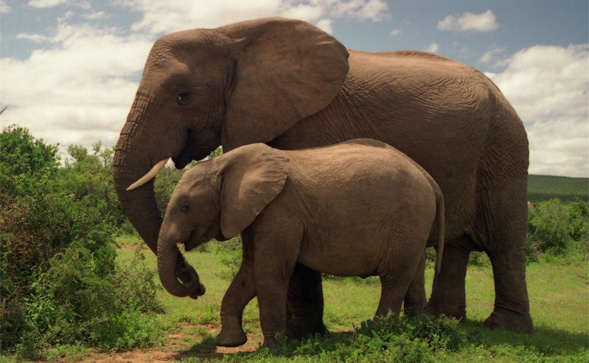Saving African Elephants
SDSUs Scott Kelley is working with a team to study African elephants and their water sources.

In the arid regions of southern Africa, elephants are known to dig wells using their feet and trunks to access water beneath the surface of dry sandy riverbeds. This behavior is observed even in areas where surface water is readily available.
A shrinking habitat, poaching, the illegal ivory trade and hunting have all contributed to the population decline, rendering a “threatened” classification on the endangered animal scale.
San Diego State University biology professor Scott Kelley is on a mission to help improve the water quality for the largest walking animals on the planet – African elephants.
The African elephant is found throughout the grassy plains and bush lands of the continent. An estimated 600 African elephants remain in the southern region of Africa.
Kelley collaborated with Lewis and Clark College undergraduate student, Eva Ramey and colleagues from Desert Elephant Conservation, Laura Brown and Rob Ramey.
The study compared levels of fecal coliform bacteria — bacteria used to detect sewage contaminated water — in water sampled from recently dug elephant wells with samples from the nearest surface water available to elephants in the arid Kunene region of northwestern Namibia. Data was collected over two field seasons.
A major issue
In addition to threats from humans, African elephants are facing an environmental issue — a contaminated water supply.
Local tribes build wells for elephants to drink from, which encourages tourism. But these wells aren’t used just by elephants. Other local fauna flock to them, which results in a massive increase of contamination.
Although the bacteria and fecal matter present in the water isn’t fatal, it compromises the immune system and quality of life for the elephants.
“It’s amazing that they can drink this water at all,” Kelley said. “It’s dangerous to ingest that much bacteria.”
Testing in the desert
A team of researchers overseen by Kelley visited the deserts of Namibia, a country in the southwestern region of Africa.
Elephants in this area have two options for drinking water — man-made wells and wells dug by elephants. The team took samples of various wells, both elephant and man-made.
“Elephants are really smart and really strong. Few animals have the capabilities to dig their own wells,” Kelley said. “The fact that they know how to find the water in the desert is pretty remarkable.”
A comparison of the samples revealed that, in fact, the elephant-made wells had significantly less contamination. Levels of fecal bacteria were higher in the man-made and every test revealed significantly lower bacterial counts in the elephant wells than in the nearest surface water or drinking pools.
Additionally, bacterial counts from the two boreholes were dramatically lower than the pools that the boreholes fed into. This explains why elephants go to great lengths to break into pumps and plumbing, to access cleaner water.
The research, conducted in collaboration with Namibia's Ministry of Environment and Tourism, can help in the development of more effective measures to protect artificial water sources that local communities depend on, and better provide for the needs of desert-dwelling elephants.
Moving forward
“Microbiology is an important aspect of animal behavior," Kelley concluded. “For elephants, no other animal — besides humans — pose a threat. Microbes will eventually kill them.”
Kelley hopes to share his research with local Namibian tribes.
“It’s incredibly important for the locals to understand why their constructed pools aren’t working,” he said. “If we want to save the elephants, one of the most important things we need to do is make sure they have access to fresh water.”
The importance of conservation is an integral part of Kelley’s research.
“If you lose these animals, you lose the culture,” Kelley said. “If these animals die, all their special nuances will die with them.”



